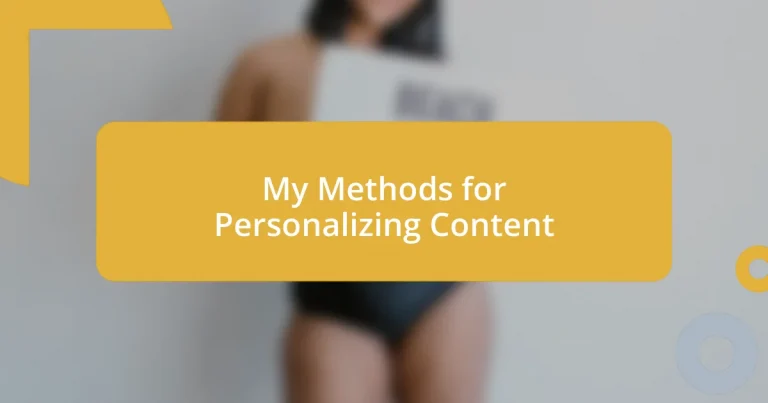Key takeaways:
- Content personalization enhances audience engagement by addressing individual preferences and pain points, creating a deeper connection.
- Effective data collection methods, including surveys and analytics, are crucial for understanding audience behavior and tailoring content accordingly.
- Continuous optimization based on user feedback and measurable goals leads to improved content strategies and sustained audience loyalty.
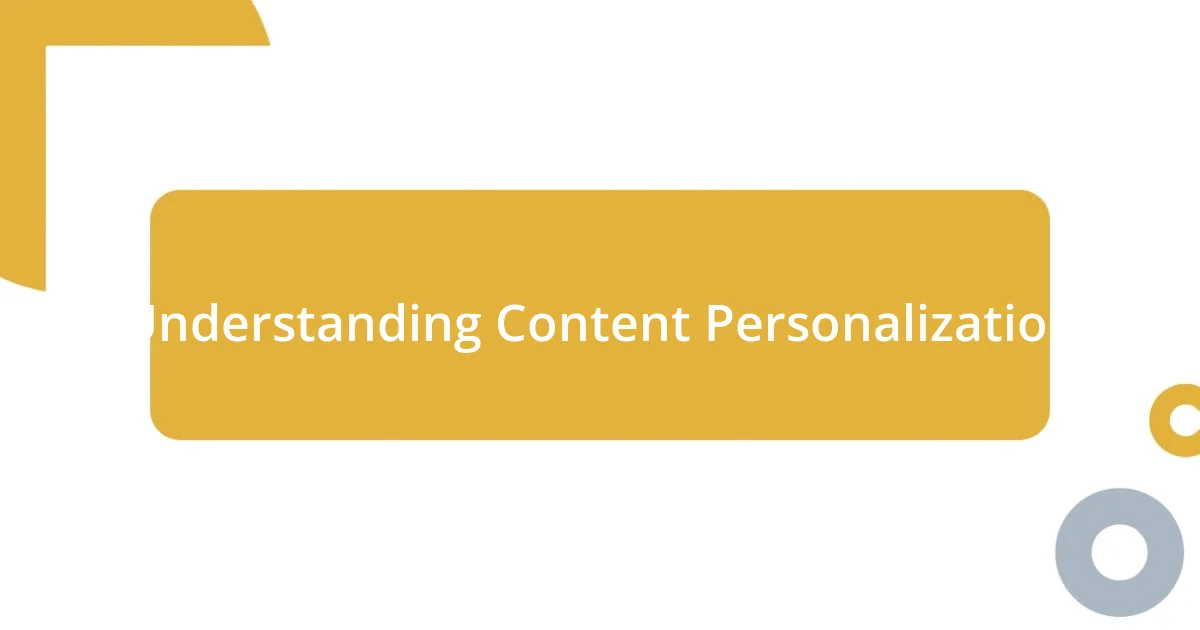
Understanding Content Personalization
Content personalization is more than just a buzzword; it’s a fundamental shift in how we interact with our audience. I remember the first time I experienced true personalization on a website—it felt like the brand knew me personally, almost as if I had a conversation with a friend. This connection made me more likely to engage and even purchase because it addressed my specific needs and preferences.
When I think about what makes content truly resonate, it’s the ability to speak directly to someone’s interests or pain points. Have you ever received a recommendation that was so spot-on it left you wondering how they knew you so well? This level of understanding stems from gathering data about user behavior, preferences, and previous interactions, allowing businesses to tailor their content in a way that feels authentic and relevant.
Moreover, personalization cultivates loyalty and trust; it shows that you value your audience as individuals rather than a faceless group. I’ve often felt more inclined to return to platforms that recognize my preferences, creating a cycle of engagement that benefits both parties. It’s not just about algorithms; it’s about weaving a narrative that speaks directly to someone’s experience, creating a bond that’s hard to break.
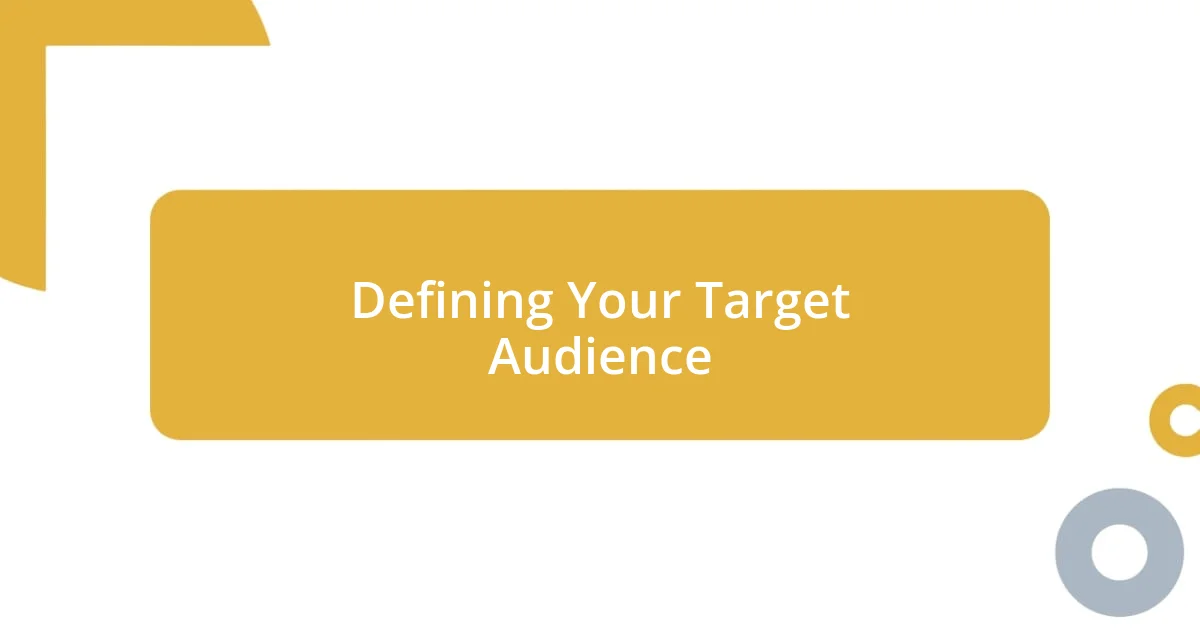
Defining Your Target Audience
To define your target audience, I’ve found that diving into their demographics and psychographics unveils a treasure trove of insights. When I took the time to analyze the age, gender, location, and interests of my audience, it was a game-changer. For example, I realized that the majority of my readers were young professionals who valued quick, actionable tips. This understanding allowed me to tailor my content to match their busy lifestyles, leading to more significant engagement.
Here are some key factors to consider when defining your target audience:
– Demographics: Age, gender, income level, education, and location.
– Psychographics: Interests, values, lifestyle, and preferences.
– Pain Points: Challenges or problems your audience is looking to solve.
– Content Preferences: Types of content they engage with (videos, blogs, social media).
– Buying Behavior: Insights on how they make purchasing decisions and what influences them.
Recognizing these components not only streamlines your content creation but also allows you to forge genuine connections with your audience. I still vividly remember the first time I tailored a piece of content based on audience feedback—it felt like having a direct line to my readers’ minds. That level of insight is invaluable, and it’s what personalized content is all about.

Collecting User Data Effectively
Collecting user data effectively is crucial for personalizing content that resonates. One method that’s worked well for me is incorporating surveys and polls directly on my website. It’s amazing how a simple question can yield profound insights about what my audience values. For instance, I once asked readers what type of content they preferred—tutorials or case studies. The feedback was enlightening and allowed me to shift my content strategy accordingly, which resulted in noticeable increases in engagement.
Another approach I advocate is utilizing analytics tools to track user behavior. These tools can provide detailed insights into page visits, click-through rates, and even user navigation paths. I remember implementing Google Analytics for the first time; it felt like I had a backstage pass to my audience’s journey. Seeing where they lingered and what made them bounce helped me refine my strategy significantly, ensuring that my content is not just seen but genuinely appreciated.
Engaging with users through social media also plays a big part in data collection. Every like, comment, or share tells me something valuable about my audience’s preferences. For example, when I launched a series of Instagram polls about content topics, the responses guided me to create articles that genuinely interested my followers. The interactive nature of social platforms helps create a community feel while delivering essential data for better personalization.
| Data Collection Method | Advantages |
|---|---|
| Surveys and Polls | Direct user feedback that facilitates content alignment with audience preferences. |
| Analytics Tools | In-depth tracking of user behavior, revealing engagement patterns and preferences. |
| Social Media Interaction | Real-time insights and fosters community engagement, influencing content direction. |
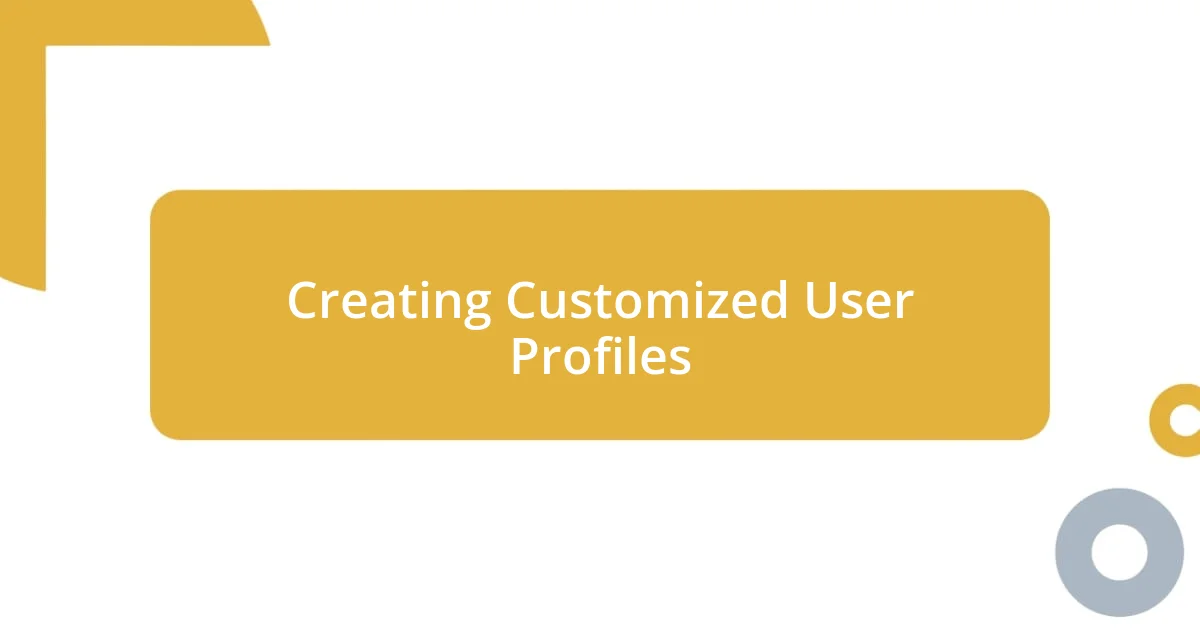
Creating Customized User Profiles
Creating customized user profiles is essential for tailoring content that resonates with your audience. I’ve found that the more detail I capture about my users, the more specific I can get with my content. For instance, when I started gathering information about my readers’ hobbies and habits, I was shocked to discover the variety of interests they had. This realization encouraged me to create segmented profiles based on these interests, allowing me to craft more targeted and engaging content.
One tool I’ve had success with is a simple questionnaire that prompts users to share details about their preferences. I remember rolling it out for the first time and feeling a rush of excitement as the responses started pouring in. It was like holding a mirror up to my audience—seeing their thoughts and feedback in real time. This data has been instrumental in shaping not only my content topics but also the tone and style I use. Have you ever asked your audience what they want and been surprised by the answers? I certainly have, and those insights often inspired incredible changes in my approach.
Once I had these profiles in place, I noticed a more personal connection with my audience. It’s like hosting a gathering where you know exactly what each guest likes to drink and eat. When I tailored my content to reflect their interests, I received messages from readers expressing their appreciation for the personalized approach. It transformed the way I viewed content creation—no longer was I just speaking into the void; I was engaging in a meaningful dialogue. Creating those customized profiles truly moved my content from generic to genuinely resonant.
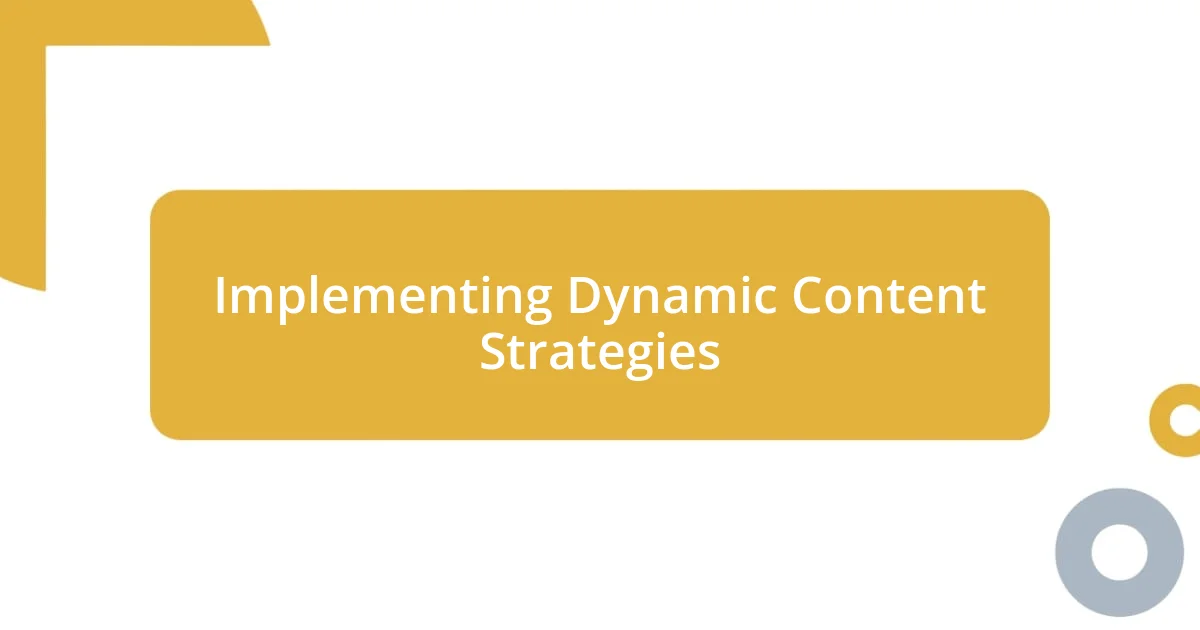
Implementing Dynamic Content Strategies
Implementing dynamic content strategies means shifting the narrative to align with individual user experiences. I vividly remember when I first experimented with dynamic content on my website. I integrated elements that changed based on user behavior, like showcasing different articles depending on what a visitor had read before. The excitement of seeing those personalized suggestions pop up made a difference in engagement metrics I couldn’t ignore.
One standout moment was when I noticed an uptick in return visitors after the changes. It made me realize how dynamic content could create a sense of familiarity—almost like welcoming back a friend. This personal touch not only kept users on my page longer but also fostered a deeper relationship with my audience. Have you ever walked into a coffee shop where the barista remembers your usual order? That’s the kind of connection I strived for, and it was incredible to see it manifest through my content.
As I refined these strategies, I learned that using data-driven insights was paramount. In one project, I aligned content recommendations with user interests gathered from interactions. I was amazed to observe how little tweaks in showing relevant videos or articles based on previous reading habits significantly boosted user engagement. It’s rewarding to know that by carefully considering user actions, I can enhance their experience and make every visit feel uniquely tailored to them. Transitioning to a dynamic approach not only energized my content strategy but reaffirmed why personalization is so powerful in today’s digital landscape.
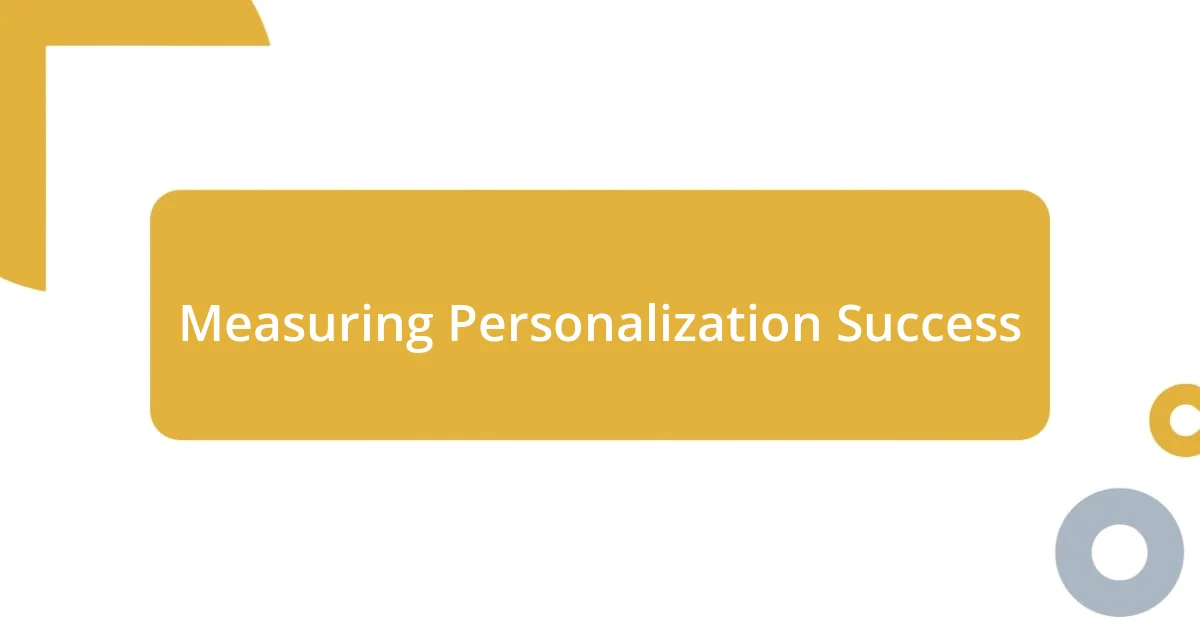
Measuring Personalization Success
Measuring the success of personalization efforts is crucial, yet it can be quite nuanced. In my experience, I’ve found that analyzing metrics like engagement rates, click-through rates, and conversion rates provides tangible indicators of how well my content resonates. It’s almost thrilling to see direct correlations; each uptick in numbers feels like a high-five from the audience. Have you ever noticed a sudden increase in engagement after tweaking your content? That moment of connection is invaluable.
I’ve also discovered the power of qualitative feedback in this mix. While numbers tell part of the story, personal messages from readers can offer profound insights. I remember receiving a heartfelt email from a reader who expressed how a particular piece of content mirrored their own struggles. That realization made me understand that measuring success isn’t solely dependent on analytics; it’s about the emotional impact my content has on individuals. Don’t you think that’s where the real magic lies?
Lastly, I’ve found that A/B testing can serve as a remarkable tool in my personalization toolkit. By trying different approaches and directly comparing how they perform, I can pinpoint what truly resonates with my audience. I still recall one A/B test where a simple change in headline phrasing led to a significant jump in engagement. It made me realize that even minor adjustments can lead to substantial shifts. Have you ever tested different strategies and stumbled upon unexpected gems? That’s the kind of discovery that makes the personalization journey even more exciting!
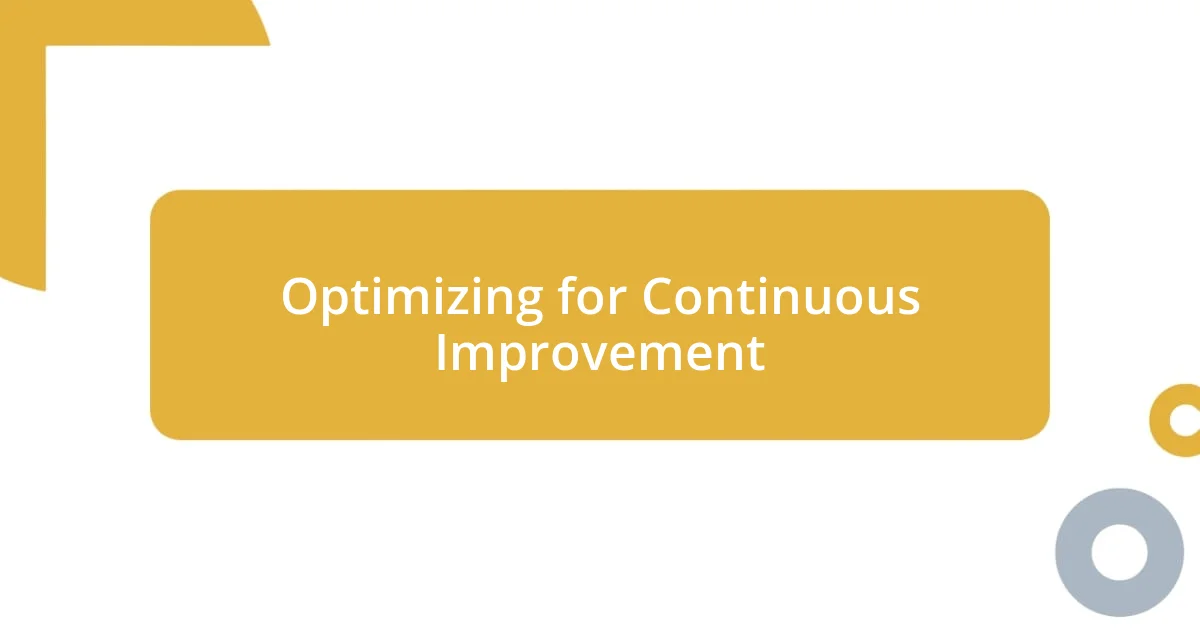
Optimizing for Continuous Improvement
Optimizing for continuous improvement is an ongoing journey that demands thorough analysis and action. I distinctly remember a period when I revisited my content strategies. By assessing user feedback and metrics regularly, I was able to pinpoint areas needing enhancement. It was like fine-tuning a musical instrument; those adjustments led to a richer, more harmonious user experience.
One time, I decided to incorporate user surveys after certain interactions. I was amazed at how many users took the time to share their thoughts. Their insights revealed not just what they liked, but also gaps in my content. Have you ever felt that rush when feedback opens new avenues of thought? It made me realize that making users feel heard could be as impactful as the content itself.
I also started setting measurable goals for each content iteration. For example, after noticing that shorter videos gained more traction, I began experimenting with varying lengths. The thrill when I achieved a 30% increase in view time was undeniable. Have you ever set a goal and felt that electric surge when you exceeded it? That’s the essence of continuous improvement—embracing change and celebrating every small victory along the way.












